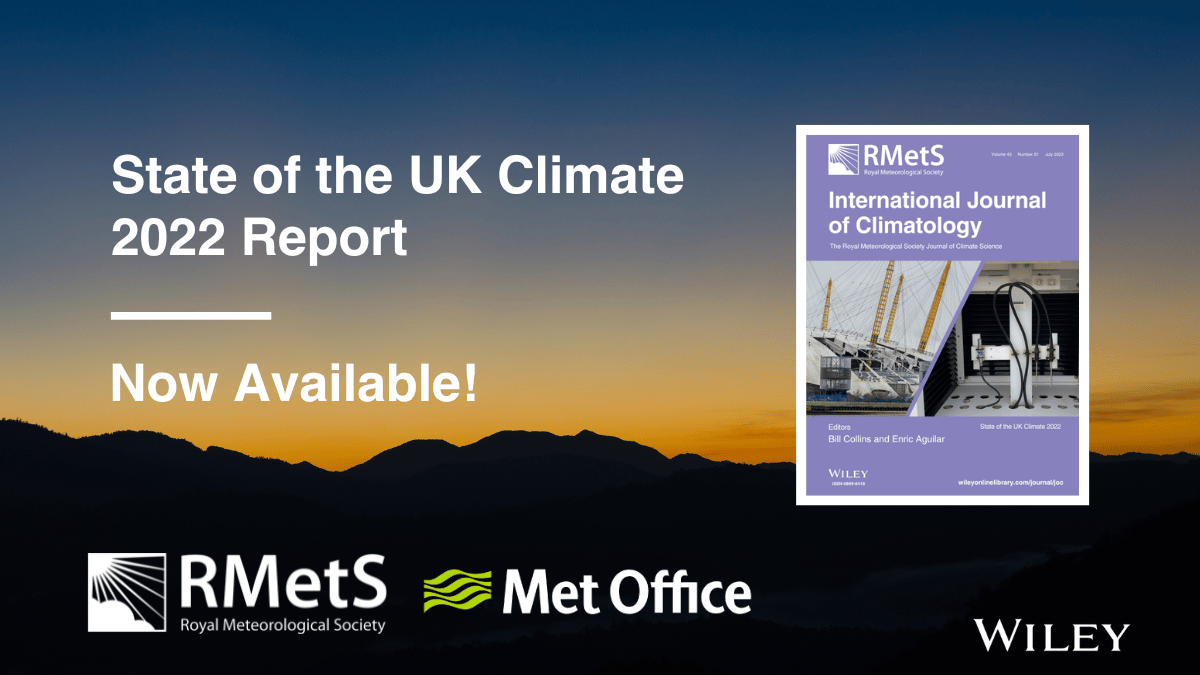

State of the UK Climate 2022
2022 was a record-breaking year for weather and is a sign of the UK’s changing climate.
The latest Met Office ‘State of the UK Climate’ report has been published today in the Society's International Journal of Climatology, examining the weather of 2022 in the context of long-term climate records.
The report highlights how the UK’s climate continues to change, with recent decades warmer, wetter and sunnier than the 20th century.
Prof Liz Bentley, Chief Executive at the Royal Meteorological Society, said: “This report is the authoritative annual summary of the UK climate. It not only helps to highlight the latest knowledge on our changing climate but also enables us to understand the trends, risks and impacts to help inform how we will need to adapt, now and in the future.
“2022 was certainly a record-breaking year for the UK and is another example that extreme heat events are becoming more frequent, intense and prolonged because of human-induced climate change – something we are seeing being played out across Europe as the report is being published”.
Although the UK has warmed at a broadly consistent rate compared to the observed change in global mean temperature, observations show that in the UK temperature extremes are changing much faster than the average temperature.
A new all-time temperature record of 40.3°C was set on 19 July during an unprecedented heatwave, exceeding the previous record by a wide margin and smashing records for many long-running stations.
Not only was 2022 the first year in the UK when 40°C was recorded, it was also the warmest year in records back to 1884. The world’s longest running instrumental temperature series dating back to 1659, the Central England Temperature (CET) record, also recorded its hottest year on record.
Met Office studies found both the record warm year and July heatwave were made more likely by human induced climate change.
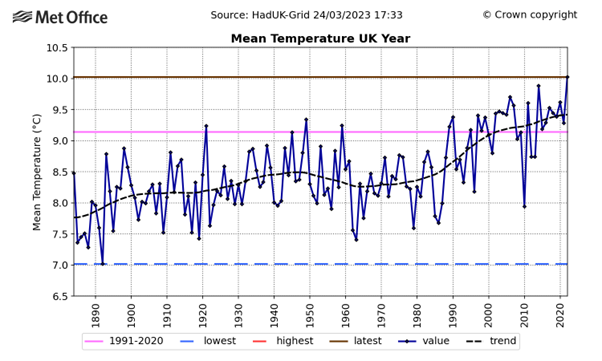
A key feature of 2022 was the persistent warmth throughout the year. All months of the year except December were warmer than the 1991-2020 average. The graph below of UK average daily maximum temperature clearly shows how many more days in the year were above average than below average. The unprecedented July heatwave stands out, as does the cold spell in December as the only significant cold spell of the year.
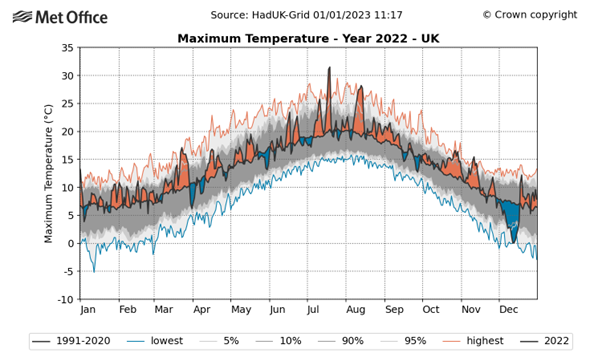
The ten-year period 2013-2022, representing a ‘snapshot’ of the UK’s current climate, is also the warmest ten-year period in both the UK series from 1884 and CET series from 1659.
The report also puts the UK’s observed climate into future context, using UKCP18 climate projections. In a medium emissions scenario (RCP4.5), by 2060 a year like 2022 would be considered an average year, by 2100 it would be considered a ‘cool’ year.
Mike Kendon from the Met Office’s National Climate Information Centre, said: “In terms of weather and climate, 2022 was an extraordinary year for the UK. It was the warmest year for the UK in our long-running record national series back to 1884, and for Central England in a series of more than three centuries. We also had an unprecedented heatwave, with 40°C recorded in the UK for the first time, marking a moment of climate history.
“However, we should not necessarily be surprised by these events: studies have shown that both the record warm year and July heatwave were both made much more likely by climate change. The observations show that extremes of temperature are changing faster than the average, and as our climate warms, we expect far more high temperature records to be broken, potentially by wide margins, and far fewer low temperature records.
“UK climate projections show that even under a medium emissions scenario a year like 2022, currently the warmest year on record, could be the norm by the middle of the century and relatively cool buy the end of the century. Our climate in the UK has a lot of year-to-year variability, but taken overall, 2022 is a potential warning of what we should expect in the future.”
The detailed annual assessment of the UK’s climate compares the current climate to historical observations of temperature, rainfall, sunshine and wind. The report also includes contributions on sea level rise and ecology from the National Oceanography Centre (NOC) and Woodland Trust respectively. The report is published in the Society’s International Journal of Climatology and is the ninth version of the annual report.
A Year of Extremes
It wasn’t just temperatures that were notable through 2022, it was the warmest year for UK near-coast sea-surface temperature (SST) in a series from 1870.
In terms of rainfall, it was a relatively dry year overall. January, March, April, July and August were all notably dry, particularly across England and Wales. The period January to August was the driest across England and Wales since 1976, resulting in water restrictions still in place in some locations. Parts of southern UK were effectively dry for the whole of July.
However, five of the 10 wettest years for the UK in a series from 1836 have occurred in the 21st century so far, and since 2009, the UK has experienced its wettest February, April, June, November and December on record. There has been a slight increase in heavy rainfall across the UK in recent decades.
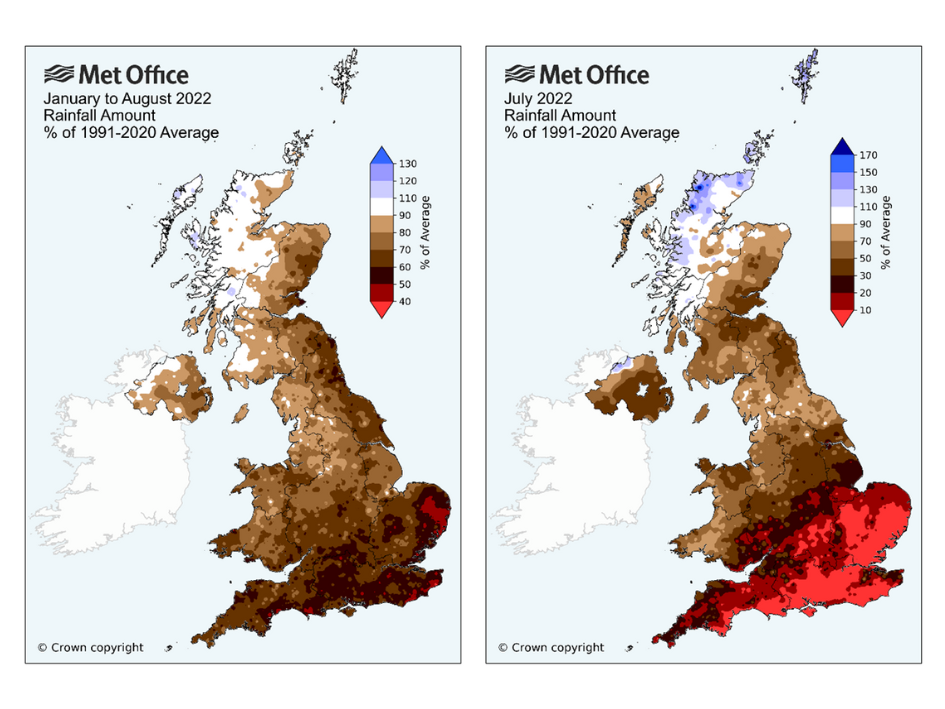
The number and severity of substantial snow events have generally declined since the 1960s and 2022 was no exception. It was one of the least snowy years on record when compared to the last sixty years. Although the frequency and severity of cold spells in the UK are reducing, the cold snap of December 2022 shows the potential for severe winter weather to still affect the UK, despite our warming climate.
When it comes to sunshine, 2022 was the equal-sixth sunniest year in the UK series from 1919. In the most recent decade (2013–2022) the UK has had on average 3% more hours of bright sunshine than the 1991–2020 average and 9% more than 1961-1990. 2013-2022 is the sunniest ten-year period in the UK series.
All five named storms in 2022 were in January and February. Storm Eunice on 18 February 2022 was the most severe storm to affect England and Wales since 12 February 2014.
Sea Level
Since the 1900s, the sea level around the UK has risen by around 18.5cm, with roughly 11.4cm of that over the past 30 years (1993-2022). The rate in which the sea level is rising is also increasing, from 1.5 ± 0.1 mm per year since the 1900s to 3.8 ± 0.9.0 mm per year between 1993-2022.
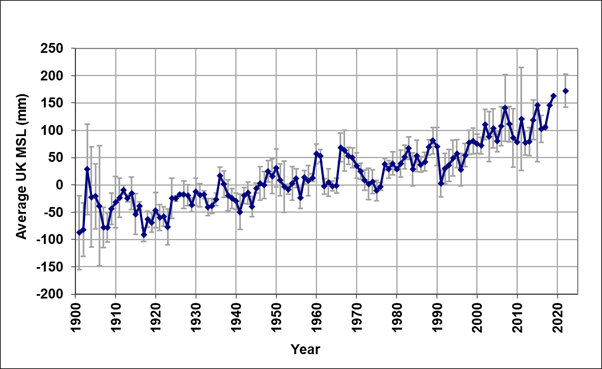
Sea level rise can have devastating consequences for coastal communities. As well as the background rise in sea level, a particular threat is from storm surges where low atmospheric pressure and strong winds push the sea even higher into coastal areas.
The most wide-spread storm surges of 2022 came with storm Eunice on 18 February, with the northern Irish Sea witnessing over 1m surges. Severe coastal flooding in the Bristol Channel and Severn Estuary was avoided as defences held.
Dr Andrew Matthews from the National Oceanography Centre said: “Tide gauge records demonstrate that sea levels around the UK are continuing to rise as water warms and ice sheets melt. 11.4 cm in the past thirty years may not sound like much, but the rate of sea level rise is increasing, and each extra centimetre increases the danger of a major storm overtopping flood defences.
“The confidence of this report in these observations highlights the ongoing need to adequately maintain the observational networks, in particular the UK weather station and tide gauge networks, to ensure that UK climate monitoring capability continues.”
Phenology
This latest report has expanded to include a wider range of species monitored for the phenology section, including four invertebrate species, four vertebrate species and four flower species to give better perspective on the UK’s ecology. Spring 2022 was an early spring by between 1-10 days for all species monitored except the Swallow. Chiffchaff had its earliest date of first song in this series from 1999, and Hazel had its second earliest flowering date.
The mild February in 2022 helped to advance the early stages of spring. Another warm October resulted in bare tree dates 1-10 days later than the baseline, with the UK mean date for Oak being the second latest in the 24-year period under investigation. Overall, the leaf-on season was 7-16 days longer than the baseline because of season extensions in both spring and autumn.
Phenologist Fritha West, of the Woodland Trust, said: “Our data show that the seasons are changing and iconic species, from birds and bumblebees to flowers and trees, are forced to alter their patterns – they are the silent witnesses of climate change.
“Much loved plants and animals, such as oak trees and ladybirds, are impacted by the shifting seasons and extreme weather events. Species will react in different ways, and these reactions will impact human life in different ways, but the speed of these changes could cause concern."
The State of the UK Climate reports have examined the changing climatology of the UK each year and been published in the International Journal of Climatology since 2017.
You can view previous editions of the report on a dedicated webpage

